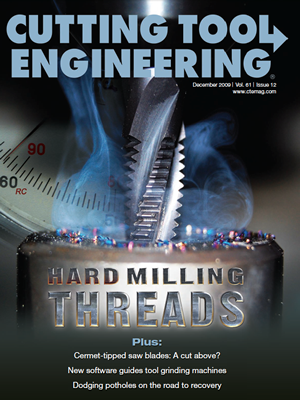Dear Doc: I’m getting burn when cylindrical OD grinding. My wheel supplier recommended a more porous wheel to improve cooling. What’s your opinion?
The Doc Replies: Don’t bother. When cylindrical grinding, the coolant removes about 5 percent of the heat (compared to up to 70 percent when creep-feed grinding). A more porous wheel might get that number up to 7 percent, meaning an extra 2 percent of the heat is not going to the workpiece. That’s not much of an improvement. Focus your energies on the grinding and dressing parameters. That’s where I’ve had the most success reducing grinding burn when cylindrical grinding.
Dear Doc: Is there a hard-and-fast rule for calculating wheel rpm as the diameter becomes smaller?
The Doc Replies: There’s a simple answer that also meets safety guidelines. If you begin at the wheel’s full diameter running at the rpm allowed to achieve the maximum surface speed, then as the diameter decreases with wheel wear and dressing you can increase the rpm using the following equation:
New rpm = original rpm × original wheel diameter ÷ current wheel diameter
Therefore, if the maximum rpm for a new wheel is 3,000 rpm and the wheel diameter starts at 18 " and goes down to 15 ", then when the wheel is at 15 " you can run it at 3,600 rpm (3,000 × 18 ÷ 15 = 3,600). That’ll provide the same surface footage as you started with and the wheel will not “act softer” or “act harder.”
However, you now have 17 percent less abrasive to do the work (3 "÷18 "), so expect about 20 percent (18 "÷15 ") more radial wheel wear.
Does this meet safety guidelines? Yes. ANSI B7.1 from the American National Standards Institute states that as the diameter gets smaller, you can increase the wheel rpm as long as the maximum surface speed—in sfm or m/sec.—established for the wheel when new is not exceeded.
Dear Doc: I flute grind tungsten-carbide tools with resin-bond diamond wheels. My wheel supplier is pushing hybrid-bond wheels. What’s your take on these wheels?
The Doc Replies: I have numerous customers flute grinding tungsten-carbide tools and have seen great results from hybrid-bond wheels. Upon further investigation, I discovered that those who hadn’t had success with them hadn’t done their due diligence in choosing the correct type of hybrid bond. Even within the family of “hybrid-bond fluting wheels” there are different bond formulations. Some formulations are for more aggressive grinding conditions with short contact lengths and some are geared toward less aggressive grinding with longer contact lengths.
You won’t be able to figure out which bond is which based on the wheel specification, so ask your wheel salesman to guide you. If he can’t, find someone who can recommend a specific hybrid-bond type/grade based on your contact length, tool size and spindle power. If the bond is too hard, your wheel will generate a lot of heat. If it’s too soft, you’ll eat up your wheel.
Finally, I’ve had hybrid-bond wheel salesmen tell me the aggressiveness of wheel conditioning, or “sticking,” should be based on the bond type. I haven’t seen this myself. My philosophy has always been to use a soft stick with small grit (50 to 75 percent of the diamond-grit size) and stick the wheel hard. But if salesmen can provide specific sticking guidelines for a particular wheel type, follow them. CTE
About the Author: Dr. Jeffrey Badger is an independent grinding consultant. His Web site is www.TheGrindingDoc.com. In January, he will conduct his “High Intensity Grinding Course” in Dublin, Ireland.
Related Glossary Terms
- abrasive
abrasive
Substance used for grinding, honing, lapping, superfinishing and polishing. Examples include garnet, emery, corundum, silicon carbide, cubic boron nitride and diamond in various grit sizes.
- coolant
coolant
Fluid that reduces temperature buildup at the tool/workpiece interface during machining. Normally takes the form of a liquid such as soluble or chemical mixtures (semisynthetic, synthetic) but can be pressurized air or other gas. Because of water’s ability to absorb great quantities of heat, it is widely used as a coolant and vehicle for various cutting compounds, with the water-to-compound ratio varying with the machining task. See cutting fluid; semisynthetic cutting fluid; soluble-oil cutting fluid; synthetic cutting fluid.
- cylindrical grinding
cylindrical grinding
Grinding operation in which the workpiece is rotated around a fixed axis while the grinding wheel is fed into the outside surface in controlled relation to the axis of rotation. The workpiece is usually cylindrical, but it may be tapered or curvilinear in profile. See centerless grinding; grinding.
- dressing
dressing
Removal of undesirable materials from “loaded” grinding wheels using a single- or multi-point diamond or other tool. The process also exposes unused, sharp abrasive points. See loading; truing.
- fluting
fluting
Cutting straight or spiral grooves in drills, endmills, reamers and taps to improve cutting action and remove chips.
- grinding
grinding
Machining operation in which material is removed from the workpiece by a powered abrasive wheel, stone, belt, paste, sheet, compound, slurry, etc. Takes various forms: surface grinding (creates flat and/or squared surfaces); cylindrical grinding (for external cylindrical and tapered shapes, fillets, undercuts, etc.); centerless grinding; chamfering; thread and form grinding; tool and cutter grinding; offhand grinding; lapping and polishing (grinding with extremely fine grits to create ultrasmooth surfaces); honing; and disc grinding.
- outer diameter ( OD)
outer diameter ( OD)
Dimension that defines the exterior diameter of a cylindrical or round part. See ID, inner diameter.
- web
web
On a rotating tool, the portion of the tool body that joins the lands. Web is thicker at the shank end, relative to the point end, providing maximum torsional strength.


